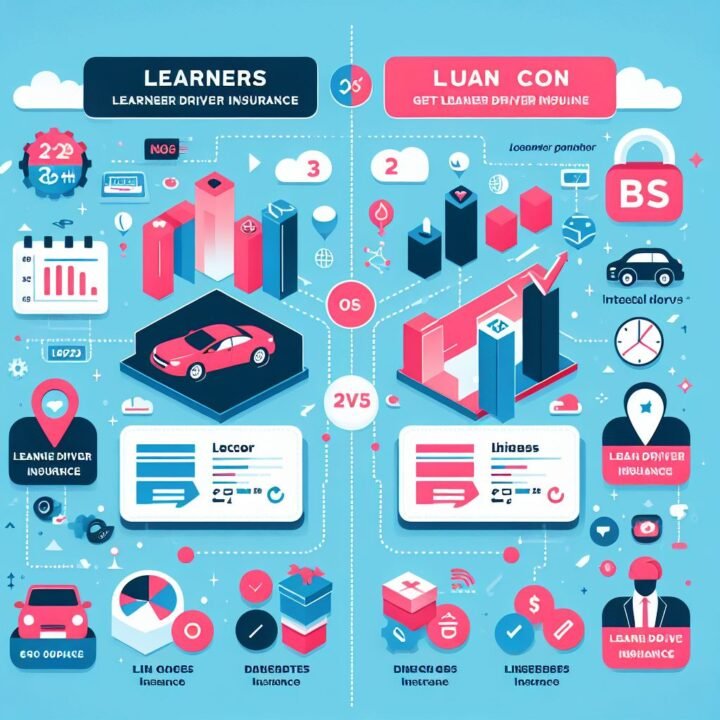
Best Learner Driver Insurance 2025/2026: Tips, Discounts, and Comparison
If you’re learning to drive, you might be wondering how to get the best learner driver insurance in 2025/2026. Learner driver insurance is a type of car insurance that covers you while you’re practising with a qualified instructor or a supervising driver. It’s different from regular car insurance, which only covers you when you have a full licence.
You need learner driver insurance because driving without insurance is illegal and can result in hefty fines, penalty points, or even disqualification. Plus, learner driver insurance can protect you and others from the financial consequences of an accident or damage to your car or someone else’s property.
What are the benefits of learner driver insurance?
Learner driver insurance has many benefits, such as:
- It can help you gain confidence and experience behind the wheel
- It can reduce the cost of your lessons by allowing you to practise with a friend or family member
- It can give you peace of mind and security while you’re learning
- It can prepare you for the transition to full car insurance when you pass your test
How to get the best learner driver insurance in 2025/2026
There are two main ways to get learner driver insurance in 2025/2026:
Option 1: Get added to an existing policy
One option is to get added as a named driver to an existing car insurance policy of someone who owns or regularly drives the car you’re using. This could be your parent, spouse, sibling, or friend. This way, you can share the cost of the insurance and benefit from their no claims bonus and discounts.
However, there are some drawbacks to this option, such as:
- It can increase the premium of the main driver, especially if you’re a young or inexperienced driver
- It can affect the no claims bonus of the main driver if you make a claim
- It can limit your choice of cars and driving hours, depending on the terms and conditions of the policy
- It can expire when you pass your test, unless you switch to a full car insurance policy
Option 2: Buy your own car insurance policy
Another option is to buy your own car insurance policy as a learner driver. This could be a standalone policy that covers you only while you’re learning, or a provisional policy that automatically converts to a full policy when you pass your test. This way, you can have more flexibility and control over your insurance and start building your own no claims bonus and discounts.
However, there are some drawbacks to this option, such as:
- It can be more expensive than being added to an existing policy, especially if you’re a young or inexperienced driver
- It can require you to pay a cancellation fee or a higher premium if you want to switch to a different insurer or policy after you pass your test
- It can have more restrictions and exclusions, such as the type of car, the age and experience of the supervising driver, and the duration and frequency of the cover
How to compare quotes from multiple insurers
Whether you choose option 1 or option 2, you should always compare quotes from multiple insurers to find the best learner driver insurance in 2025/2026. You can do this by using online comparison sites, such as [MoneySuperMarket], [Confused.com], or [Compare the Market], or by contacting insurers directly, such as [Admiral], [Aviva], or [Direct Line].
When comparing quotes, you should consider the following factors:
- The price of the premium and the excess
- The level and type of cover
- The features and benefits
- The terms and conditions
- The customer reviews and ratings

How to choose a car that’s cheap to insure
One of the most important factors that affect the cost of learner driver insurance is the car you’re driving. Generally, the cheaper, smaller, and safer the car, the lower the premium. This is because insurers use a car insurance group system to rate cars based on their performance, security, repair costs, and claims history. The lower the group, the lower the risk, and the lower the premium.
To choose a car that’s cheap to insure, you should look for the following features:
- A low engine size and power
- A high safety rating and features
- A low theft risk and anti-theft devices
- A low mileage and age
- A standard model and colour
Some examples of cars that are cheap to insure for learner drivers are:
- Ford Fiesta
- Volkswagen Polo
- Hyundai i10
- Toyota Yaris
- Renault Clio
How to increase your voluntary excess
Another way to lower the cost of learner driver insurance is to increase your voluntary excess. This is the amount of money you agree to pay towards a claim before the insurer pays the rest. The higher the excess, the lower the premium, as you’re taking on more of the risk.
However, you should only increase your excess to a level that you can afford to pay in case of a claim. Otherwise, you might end up paying more than you save. You should also consider the compulsory excess, which is the amount of money the insurer requires you to pay towards a claim regardless of your voluntary excess. The total excess is the sum of the voluntary and compulsory excess.
How to add a low-risk driver as a named driver
Another way to lower the cost of learner driver insurance is to add a low-risk driver as a named driver to your policy. This is someone who has a full licence, a good driving record, and a lot of experience behind the wheel. This could be your parent, spouse, sibling, or friend. By adding a low-risk driver, you can show the insurer that you’re less likely to make a claim, as you’ll be supervised by a responsible driver.
However, you should only add a low-risk driver if they actually drive the car occasionally. Otherwise, you might be accused of fronting, which is a type of insurance fraud where you pretend that someone else is the main driver of the car to get a cheaper premium. This is illegal and can result in your policy being cancelled, your claim being rejected, or even prosecution.
How to pay annually rather than monthly
Another way to lower the cost of learner driver insurance is to pay annually rather than monthly. This is because insurers usually charge interest and fees for spreading the payment over 12 months, which can add up to a significant amount. By paying annually, you can avoid these extra charges and save money in the long run.
However, you should only pay annually if you have enough money to do so. Otherwise, you might struggle to afford other expenses or emergencies. You should also compare the annual and monthly payments to see how much you can save and whether it’s worth it.
How to avoid modifications to your car
Another way to lower the cost of learner driver insurance is to avoid modifications to your car. These are any changes or additions to the car that alter its appearance, performance, or function from the original manufacturer’s specifications. This could include things like:
- Alloy wheels
- Spoilers
- Tinted windows
- Sound systems
- Engine upgrades
Modifications can increase the cost of learner driver insurance because they can make the car more attractive to thieves, more expensive to repair, or more likely to cause an accident. Insurers might also consider modifications as a sign of a risky driver who likes to speed or show off. Therefore, you should keep your car as standard as possible, or declare any modifications to your insurer and pay the extra premium.
How to use a black box or telematics device
Another way to lower the cost of learner driver insurance is to use a black box or telematics device. This is a small gadget that’s installed in your car or connected to your smartphone, and tracks your driving behaviour, such as:
- Speed
- Acceleration
- Braking
- Cornering
- Mileage
- Time of day
The data is then sent to your insurer, who can adjust your premium based on how well you drive. The better you drive, the lower your premium. This can encourage you to drive more safely and responsibly, and reward you for doing so.
However, you should be aware of the potential drawbacks of using a black box or telematics device, such as:
- It can limit your driving hours, as some insurers charge more or less depending on the time of day you drive
- It can limit your mileage, as some insurers set a maximum number of miles you can drive per year or per month
- It can limit your freedom, as some insurers monitor where you drive and who you drive with
- It can invade your privacy, as some insurers share your data with third parties or use it for marketing purposes
How to drive safely and build up your no claims bonus
Another way to lower the cost of learner driver insurance is to drive safely and build up your no claims bonus. This is a discount that you get for every year that you don’t make a claim on your policy. The longer you go without a claim, the bigger the discount. This can show the insurer that you’re a careful and reliable driver, and reduce your premium significantly.
To drive safely and build up your no claims bonus, you should follow these tips:
- Follow the rules of the road, such as speed limits, traffic signs, and signals
- Keep a safe distance from other vehicles, especially in bad weather or heavy traffic
- Avoid distractions, such as using your phone, eating, or drinking while driving
- Be alert and aware of your surroundings, such as pedestrians, cyclists, and animals
- Plan your route and journey ahead, and avoid driving when you’re tired, stressed, or unwell
How to get a discount for passing a driving course
Another way to lower the cost of learner driver insurance is to get a discount for passing a driving course. This is a voluntary course that you can take after you pass your theory test and before you take your practical test. It can help you improve your driving skills, confidence, and safety on the road. Some examples of driving courses are:
- Pass Plus
- Advanced driving skills
- Defensive driving
- Eco-driving
By passing a driving course, you can get a discount on your learner driver insurance, as some insurers recognise the benefits of these courses and offer lower premiums to drivers who complete them. However, you should check with your insurer before you enrol in a course, as not all of them accept or reward these courses. You should also weigh the cost of the course against the potential savings on your insurance, and see if it’s worth it.
How much does learner driver insurance cost in 2025/2026?
The cost of learner driver insurance in 2025/2026 depends on various factors, such as:
- Your age and experience
- Your location and postcode
- Your car and its insurance group
- Your driving history and record
- Your cover level and type
- Your excess and payment method
- Your driving behaviour and habits
According to [MoneySuperMarket], the average cost of learner driver insurance in 2025/2026 is £1,234 per year, or £103 per month. However, this is just an estimate, and your actual cost may vary depending on your personal circumstances and preferences.
Average car insurance rates for drivers with a learner’s permit
To give you an idea of how much learner driver insurance costs in 2025/2026, here are some average car insurance rates for drivers with a learner’s permit, based on [MoneySuperMarket] data:
- By age: The younger you are, the more you pay, as insurers see you as a higher risk. For example, the average cost of learner driver insurance for a 17-year-old is £2,012 per year, while the average cost for a 25-year-old is £926 per year.
- By gender: The gender gap in car insurance has been banned since 2012, but there are still some differences in the rates for men and women, due to other factors, such as the type of car and the driving behaviour. For example, the average cost of learner driver insurance for a male driver is £1,269 per year, while the average cost for a female driver is £1,199 per year.
- By location: The area where you live and drive can affect the cost of your learner driver insurance, as insurers take into account the crime rate, the traffic density, and the accident frequency in your postcode. For example, the average cost of learner driver insurance in London is £1,544 per year, while the average cost in Scotland is £893 per year.
- By car: The car you drive can have a big impact on the cost of your learner driver insurance, as insurers use the car insurance group system to rate cars based on their risk. For example, the average cost of learner driver insurance for a Ford Fiesta, which is in group 2, is £1,026 per year, while the average cost for a BMW 3 Series, which is in group 32, is £1,789 per year.
How to save money on learner driver insurance in 2025/2026
As you can see, learner driver insurance can be quite expensive, especially if you’re a young or inexperienced driver. However, there are some ways to save money on learner driver insurance in 2025/2026, such as:
- Compare quotes from multiple insurers
- Choose a car that’s cheap to insure
- Increase your voluntary excess
- Add a low-risk driver as a named driver
- Pay annually rather than monthly
- Avoid modifications to your car
- Use a black box or telematics device
- Drive safely and build up your no claims bonus
- Get a discount for passing a driving course
What kind of car insurance do you need with a learner’s permit?
When you’re looking for the best learner driver insurance in 2025/2026, you should also consider the kind of car insurance you need with a learner’s permit. Car insurance can be divided into three main levels of cover:
- Third party only: This is the minimum level of cover required by law. It covers the damage or injury you cause to other people or their property, but not to your own car or yourself.
- Third party, fire and theft: This is the same as third party only, but it also covers your car if it’s stolen or damaged by fire.
- Comprehensive: This is the highest level of cover available. It covers everything that third party, fire and theft does, but it also covers your car and yourself if you’re involved in an accident, regardless of who’s at fault.
The level of cover you choose depends on your budget, your car, and your preferences. Generally, comprehensive cover is the most expensive, but it also offers the most protection. Third party only cover is the cheapest, but it also offers the least protection. Third party, fire and theft cover is somewhere in between, and it might be a good option if you have a low-value car that’s not worth repairing or replacing.
However, you should also be aware that the level of cover is not the only factor that affects the cost of learner driver insurance. Other factors, such as the ones mentioned above, can also influence the price. Therefore, you should always compare quotes from different insurers and levels of cover to find the best deal for you.
What happens to your insurance when you pass your test?
One of the most exciting moments of learning to drive is passing your test and getting your full licence. However, this also means that you need to update your learner driver insurance, as it might no longer be valid or suitable for you.
Depending on the type of learner driver insurance you have, there are two possible scenarios:
If you have your own policy
If you have your own policy as a learner driver, you need to inform your insurer that you’ve passed your test as soon as possible. They will then adjust your policy accordingly, which might involve:
- Changing your cover level and type
- Changing your premium and excess
- Changing your terms and conditions
- Changing your features and benefits
Depending on your insurer and policy, this might result in a higher or lower premium, or a cancellation fee or a refund. You should check with your insurer before you pass your test to see what changes they will make and how they will affect you.
Alternatively, you can also cancel your learner driver policy and switch to a different insurer or policy that offers better value or more suitable cover for you as a full licence holder. However, you should also check the cancellation terms and fees of your current policy, and compare them with the quotes and benefits of the new policy, to see if it’s worth it.
If you’re a named driver on someone else’s policy
If you’re a named driver on someone else’s policy, such as your parent, spouse, sibling, or friend, you also need to inform the main driver and the insurer that you’ve passed your test as soon as possible. They will then adjust the policy accordingly, which might involve:
- Removing you from the policy
- Changing your cover level and type
- Changing the premium and excess
- Changing the terms and conditions
- Changing the features and benefits
Depending on the insurer and policy, this might result in a higher or lower premium, or a cancellation fee or a refund, for the main driver. You should check with the main driver and the insurer before you pass your test to see what changes they will make and how they will affect you and them.
Alternatively, you can also stay on the policy as a named driver, but you might need to pay a higher premium, as you’re no longer a learner driver. You should also check the terms and conditions of the policy, as some insurers might have restrictions or exclusions for named drivers who have a full licence.
Frequently asked questions on Best Learner Driver Insurance 2025/2026
Here are some of the most frequently asked questions about learner driver insurance in 2025/2026, and their answers:
Can you drive alone with a learner’s permit?
No, you can’t drive alone with a learner’s permit. You must always be accompanied by a qualified instructor or a supervising driver who has a full licence, is over 21 years old, and has at least three years of driving experience. You must also display L plates on the front and rear of your car, and follow the rules and restrictions of your learner’s permit, such as the speed limit, the driving hours, and the type of road.
How long does a learner’s permit last?
A learner’s permit lasts for two years from the date of issue. You can renew it for another two years if you haven’t passed your test by then, but you’ll have to pay a fee and retake your theory test. You can apply for a learner’s permit when you’re 15 years and 9 months old, but you can only start driving when you’re 17 years old, or 16 years old if you receive the higher rate of the mobility component of Disability Living Allowance.
What happens if you get into an accident with a learner’s permit?
If you get into an accident with a learner’s permit, you should follow the same steps as any other driver, such as:
Stop and check if anyone is injured
Call the emergency services if necessary
Exchange details with the other driver and any witnesses
Take photos and notes of the scene and the damage
Report the accident to your insurer as soon as possible
However, you should also be aware that your learner driver insurance might not cover you fully if you’re at fault or partly at fault for the accident, depending on the level and type of cover you have. You might also lose your no claims bonus or have to pay a higher excess. You should check your policy documents and terms and conditions to see what your rights and responsibilities are in case of an accident.
Can you rent a car with a learner’s permit?
No, you can’t rent a car with a learner’s permit. Most car rental companies require you to have a full licence, be over 21 years old, and have at least one year of driving experience. Some car rental companies might also charge you a young driver surcharge if you’re under 25 years old. Therefore, you should wait until you pass your test and get your full licence before you rent a car.
Can you drive out of state with a learner’s permit?
Yes, you can drive out of state with a learner’s permit, as long as you follow the rules and restrictions of both your home state and the state you’re visiting. You should also carry your learner’s permit, your proof of insurance, and your identification with you at all times. However, you should also be aware that some states might have different requirements or laws for learner drivers, such as the age and experience of the supervising driver, the type of road, and the driving hours. Therefore, you should check the regulations of the state you’re visiting before you drive there.
Can you drive at night with a learner’s permit?
Yes, you can drive at night with a learner’s permit, as long as you’re accompanied by a qualified instructor or a supervising driver who meets the criteria mentioned above. However, you should also be careful and cautious when driving at night, as it can be more challenging and dangerous than driving during the day. You should also check the terms and conditions of your learner driver insurance, as some insurers might charge you more or less depending on the time of day you drive.
Can you drive on the highway with a learner’s permit?
Yes, you can drive on the highway with a learner’s permit, as long as you’re accompanied by a qualified instructor or a supervising driver who meets the criteria mentioned above. However, you should also be confident and competent when driving on the highway, as it can be more complex and stressful than driving on other roads. You should also check the terms and conditions of your learner driver insurance, as some insurers might have restrictions or exclusions for driving on the highway.
How do I get cheap car insurance for young drivers?
If you’re a young driver, you might find it hard to get cheap car insurance, as insurers see you as a higher risk due to your age and inexperience. However, there are some ways to get cheap car insurance for young drivers, such as:
Compare quotes from multiple insurers
Choose a car that’s cheap to insure
Increase your voluntary excess
Add a low-risk driver as a named driver
Pay annually rather than monthly
Avoid modifications to your car
Use a black box or telematics device
Drive safely and build up your no claims bonus
Get a discount for passing a driving course
How do I get car insurance for a provisional licence?
If you have a provisional licence, you need to get learner driver insurance, which is a type of car insurance that covers you while you’re practising with a qualified instructor or a supervising driver. You can get learner driver insurance by either:
Getting added to an existing policy of someone who owns or regularly drives the car you’re using
Buying your own car insurance policy as a learner driver
You should compare quotes from different insurers and levels of cover to find the best deal for you.
How do I get car insurance for a full licence?
If you have a full licence, you need to get regular car insurance, which is a type of car insurance that covers you when you drive on your own or with passengers. You can get regular car insurance by either:
Switching to a full car insurance policy with your current insurer
Cancelling your learner driver policy and switching to a different insurer or policy
You should compare quotes from different insurers and levels of cover to find the best deal for you.
Conclusion
Learner driver insurance is a type of car insurance that covers you while you’re learning to drive with a qualified instructor or a supervising driver. It’s different from regular car insurance, which only covers you when you have a full licence.
To get the best learner driver insurance in 2025/2026, you should:
- Compare quotes from multiple insurers
- Choose a car that’s cheap to insure
- Increase your voluntary excess
- Add a low-risk driver as a named driver
- Pay annually rather than monthly
- Avoid modifications to your car
- Use a black box or telematics device
- Drive safely and build up your no-claims bonus
- Get a discount for passing a driving course
You can also choose between two options to get learner driver insurance:
- Get added to an existing policy of someone who owns or regularly drives the car you’re using
- Buy your own car insurance policy as a learner driver
You should also consider the kind of car insurance you need with a learner’s permit, such as:
- Third-party only
- Third-party, fire, and theft
- Comprehensive
You should also update your learner driver insurance when you pass your test, as it might no longer be valid or suitable for you. You can either:
- Switch to a full car insurance policy with your current insurer
- Cancel your learner driver policy and switch to a different insurer or policy
Learner driver insurance can be expensive, especially if you’re a young or inexperienced driver. However, by following these tips and tricks, you can save money and get the best learner driver insurance in 2025/2026.
If you’re ready to start your journey to becoming a confident and safe driver, don’t wait any longer. Get your learner driver insurance today and hit the road with peace of mind. You can compare quotes from the best insurers in the UK by clicking the button below. Happy driving!







